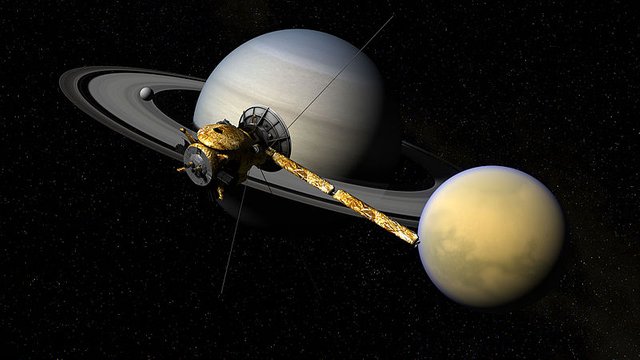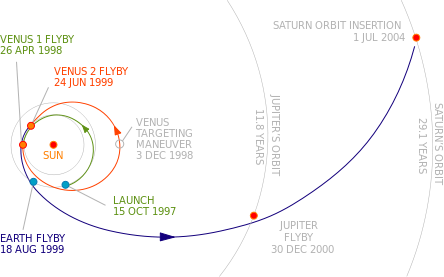Mission of Cassini and Huygens

After twenty years, the Cassini-Huygens mission finally came to an end. On September 15, 2017, the Cassini orbiter uses its remaining fuel to "kill itself" by plunging into Saturn. During its journey into space, this mission has sent an abundance of data to Earth, and world scientists have turned it into new information. How is the story complete?
Cassini and Huygens
The Cassini-Huygens mission (commonly called the Cassini mission) is a collaboration between the National Aeronautics and Space Administration (NASA), the European Space Agency (ESA), and the Italian Space Agency (Agenzia Spaziale Italiana, ASI) to investigate the Saturn's planet system: atmosphere, , the magnetosphere, and the satellites. The mission uses a spacecraft consisting of an orbiting spacecraft, Cassini, and a lander, Huygens. This spacecraft is the second largest interplanetary plane ever launched, with a total weight of about 5.6 tons. Cassini-Huygens is equipped with various instruments to support research, including spectrometers, magnetometers, imaging systems, and communication systems.
Because Cassini will spend years in the Saturn Planet system, practical solar power can not be used as a source of energy. Therefore, Cassini uses decay of plutonium dioxide as a heat source which is then converted into electricity to operate the instrument. Meanwhile, to support the movement of the aircraft (such as changing orientation or shifting the orbital path) Cassini utilizes two engines with nitrogen tetraoxide as its oxidizer and monomethyl-hydrazine as its fuel.
Implementation of Mission
On October 15, 1997, the Titan IVB / Centaur rocket carrying the Cassini-Huygens rides was launched from Cape Canaveral, Florida. After escaping from the Earth's gravitational field, Cassini first flies toward the inner Solar System, which is toward Venus. This is done to get enough encouragement to reach the distant orbit of Saturn. Cassini did four flybys to get gravity help from Venus, Earth, and Jupiter until finally arriving at Saturn after 6.7 years of travel.
After entering Saturn's orbit and flying through several satellites, Cassini reached Saturn's largest satellite, the Titan. On December 25, 2004, the Huygens lander plane that had been "asleep" for years was finally released from Cassini to make his own journey to the surface of Titan. For 20 days, Huygens, who had escaped from his mother plane, hovered over Titan as he drew closer until it finally landed on the surface of Titan safely.
Huygens's duties began when he entered Titan's atmosphere. The Huygens system is turned on and all sensors are turned on. Cassini "guarded" over the orbit as an information broker between Huygens and Earth. Huygens, which had been designed to land on both the solid plains and the waters, had fallen on an area of land with icy rock spread. Huygens spends 2.5 hours in the atmosphere and 72 minutes on the Titan surface, and has managed to deliver 350 imagery (from 700 previously planned imagery) to Earth.
After 3.6 hours of data gathering, Huygens mission was completed. Cassini then continued his journey collecting data related to Titan, Enceladus, Iapetus, and Saturn's rings. Some of the new things that have been discovered include the presence of water in liquid form in Enceladus, a lake on Titan that is thought to contain methane and ethane, as well as interesting features of Iapetus. Cassini has also identified a major storm on Saturn's south pole that resembles cyclone storms on Earth.
In mid 2008, the main task of Cassini mission has been completed. Furthermore, this mission undergoes a two-time extension. The first renewal mission, called the Cassini Equinox Mission, began in July 2008 and ends in October 2010. The goal is to continue research on what has been found on the main mission. The second extension mission, called Cassini Solstice Mission, is implemented until 2017. This extension mission allows Cassini to study the effects of seasons on the Saturn planet system.
Grand Finale
After twelve more years of being on Saturn, the remaining fuel on Cassini began to thin. If Cassini is left alone, then in the next few years, when its fuel is completely exhausted, mission operators will no longer be able to control it from Earth. It is not impossible that Cassini could experience a collision with Titan and Enceladus in the future, and that is not a good thing considering that both have the possibility of sustaining a simple life. Collisions with Cassini may cause the "ecosystem" to be disturbed, or otherwise, the microbes from Earth that may still survive and stick to Cassini may contaminate both months.
To avoid contamination of Titan and Enceladus, in 2010, right at the beginning of the Cassini Solstice Mission period, a scenario was chosen to deploy Cassini to the atmosphere of Saturn. Saturn has no atmosphere that can support life-that-we-know, so that the fall of Cassini to Saturn is safe. In addition, this scenario involves long maneuvers that allow to retrieve scientific data that has never been obtained before.
The final scenario of Cassini's mission, called Cassini Grand Finale, involves a series of maneuvers consisting of 22 rounds (loops). From April to September 2017, more or less every week, Cassini "dives" into the gap between Saturn and its ring. Grand Finale is something very interesting, because the "dive" to the gap between Saturn and the ring has never been done before. During the 22 rounds, Cassini can take Saturn's spectacular images and rings from very close range, and mapped Saturn's magnetic field and magnetic field in detail. Even when the seconds finally did, precisely when Cassini began to enter the atmosphere of Saturn, Cassini continues to transmit new data in real-time to lose contact with Earth. Grand Finale Cassini is more than just the end, it can even be said that Grand Finale is a mission in itself.
How is Cassini doing now? What is clear, shortly after entering Saturn's atmosphere, friction with the atmosphere will make it scattered and then burn like a meteor. The rest of the surviving material will "sink" deeper before it finally melts and crumbles from heat and high pressure. Cassini has now become fully part of Saturn.
Before plunging into Saturn, Cassini captured his final image. The image depicts the location where Cassini will enter the atmosphere a few hours later.
Long wait
Although Huygens land craft has spent years to reach Saturn, Huygens' active time on Titan is no more than four hours. After the task was completed, Cassini's radio antenna was directed in the other direction and Cassini lost contact with Huygens. However, although we can no longer hear it, Huygens is still on the surface of Titan today.
For the twelve years since its landing, the winds and rocks on Titan might have eroded Huygens little by little. The existing instrument may have been corrupted at this time. But besides, Huygens still brings something else. Reporting from the BBC, a team from NASA has turned out to have inserted a DVD containing pictures, messages, and signatures from people in various countries. This DVD is like a "message in a bottle" for Saturn, waiting to be opened by mankind in the future when interplanetary exploration is possible. Given that Titan is one of the possible candidates for life in the Solar System, Huygens probably did not have to wait too long to meet humans. Maybe a few more centuries?
Best Regard @t4r1
Reference :
https://saturn.jpl.nasa.gov/
http://sci.esa.int/cassini-huygens/
http://news.bbc.co.uk/2/hi/science/nature/6135450.stm
http://www.bbc.co.uk/news/resources/idt-sh/cassini_huygens_saturn


Hi, I found some acronyms/abbreviations in this post. This is how they expand:
Congratulations! This post has been upvoted from the communal account, @minnowsupport, by abumuhammad from the Minnow Support Project. It's a witness project run by aggroed, ausbitbank, teamsteem, theprophet0, someguy123, neoxian, followbtcnews, and netuoso. The goal is to help Steemit grow by supporting Minnows. Please find us at the Peace, Abundance, and Liberty Network (PALnet) Discord Channel. It's a completely public and open space to all members of the Steemit community who voluntarily choose to be there.
If you would like to delegate to the Minnow Support Project you can do so by clicking on the following links: 50SP, 100SP, 250SP, 500SP, 1000SP, 5000SP.
Be sure to leave at least 50SP undelegated on your account.